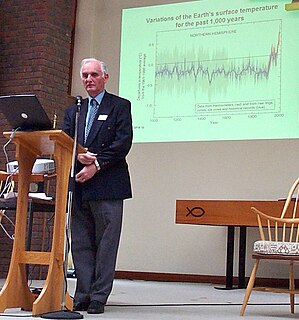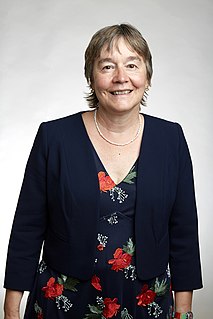
The instrumental temperature record provides the temperature of Earth's climate system from the historical network of in situ measurements of surface air temperatures and ocean surface temperatures. Data are collected at thousands of meteorological stations, buoys and ships around the globe. The longest-running temperature record is the Central England temperature data series, which starts in 1659. The longest-running quasi-global record starts in 1850. In recent decades more extensive sampling of ocean temperatures at various depths have begun allowing estimates of ocean heat content but these do not form part of the global surface temperature datasets.

The temperature record of the past 1,000 years or longer is reconstructed using data from climate proxy records in conjunction with the modern instrumental temperature record which only covers the last 150 years at a global scale. Large-scale reconstructions covering part or all of the 1st millennium and 2nd millennium have shown that recent temperatures are exceptional: the Intergovernmental Panel on Climate Change Fourth Assessment Report of 2007 concluded that "Average Northern Hemisphere temperatures during the second half of the 20th century were very likely higher than during any other 50-year period in the last 500 years and likely the highest in at least the past 1,300 years." The curve shown in graphs of these reconstructions is widely known as the hockey stick graph because of the sharp increase in temperatures during the last century. As of 2010 this broad pattern was supported by more than two dozen reconstructions, using various statistical methods and combinations of proxy records, with variations in how flat the pre-20th-century "shaft" appears. Sparseness of proxy records results in considerable uncertainty for earlier periods.

Michael Evan Mann is an American climatologist and geophysicist, currently director of the Earth System Science Center at Pennsylvania State University, who has contributed to the scientific understanding of historic climate change based on the temperature record of the past thousand years. He has pioneered techniques to find patterns in past climate change, and to isolate climate signals from noisy data.
The Center for the Study of Carbon Dioxide and Global Change is a 501(c)(3) non-profit organization based in Tempe, Arizona. The Center produces a weekly online science newsletter called CO2Science.

The description of the Medieval Warm Period and Little Ice Age in IPCC reports has changed since the first report in 1990 as scientific understanding of the temperature record of the past 1000 years has improved. The Medieval Warm Period (MWP) and Little Ice Age (LIA) are the best-known temperature fluctuations in the last millennium.
Climate sensitivity is the globally averaged temperature change in response to changes in radiative forcing, which can occur, for instance, due to increased levels of carbon dioxide (CO
2). Although the term climate sensitivity is usually used in the context of radiative forcing by CO2, it is thought of as a general property of the climate system: the change in surface air temperature following a unit change in radiative forcing, and the climate sensitivity parameter is therefore expressed in units of °C/(W/m2). The measure is approximately independent of the nature of the forcing (e.g. from greenhouse gases or solar variation). When climate sensitivity is expressed for a doubling of CO2, its units are degrees Celsius (°C).
Raymond S. "Ray" Bradley is a climatologist and University Distinguished Professor in the Department of Geosciences at the University of Massachusetts Amherst, where he is also research director of the Climate System Research Center. Bradley's work indicates that the warming of Earth's climate system in the twentieth century is inexplicable via natural mechanisms.

Global warming is the long-term rise in the average temperature of the Earth's climate system. It is a major aspect of climate change, and has been demonstrated by direct temperature measurements and by measurements of various effects of the warming. The terms global warming and climate change are often used interchangeably. However, speaking more accurately, global warming denotes the mainly human-caused increase in global surface temperatures and its projected continuation, but climate change includes both global warming and its effects, such as changes in precipitation. While there have been prehistoric periods of global warming, many observed changes since the mid-20th century have been unprecedented over decades to millennia.

Hockey stick graphs present the global or hemispherical mean temperature record of the past 500 to 2000 years as shown by quantitative climate reconstructions based on climate proxy records. These reconstructions have consistently shown a slow long term cooling trend changing into relatively rapid warming in the 20th century, with the instrumental temperature record by 2000 exceeding earlier temperatures.

In the hockey stick controversy, the data and methods used in reconstructions of the temperature record of the past 1000 years have been disputed. Reconstructions have consistently shown that the rise in the instrumental temperature record of the past 150 years is not matched in earlier centuries, and the name "hockey stick graph" was coined for figures showing a long-term decline followed by an abrupt rise in temperatures. These graphs were publicised to explain the scientific findings of climatology, and in addition to scientific debate over the reconstructions, they have been the topic of political dispute. The issue is part of the global warming controversy and has been one focus of political responses to reports by the Intergovernmental Panel on Climate Change (IPCC). Arguments over the reconstructions have been taken up by fossil fuel industry–funded lobbying groups attempting to cast doubt on climate science.
This is a list of climate change topics.
The Soon and Baliunas controversy involved the publication in 2003 of a review study written by aerospace engineer Willie Soon and astronomer Sallie Baliunas in the journal Climate Research, which was quickly taken up by the G.W. Bush administration as a basis for amending the first Environmental Protection Agency Report on the Environment.
Joseph D'Aleo is a certified consultant meteorologist and the first Director of Meteorology at The Weather Channel. He was chairman of the American Meteorological Society's Committee on Weather Analysis and Forecasting. He was the founder of the "Icecap" blog. He has been a contributing meteorologist to the Old Farmer's Almanac, in which he predicted in 2008 that the earth had entered a period of global cooling. D'Aleo is currently a meteorologist at Weatherbell Analytics.
The Wegman Report was prepared in 2006 by three statisticians led by Edward Wegman at the request of Rep. Joe Barton of the United States House Committee on Energy and Commerce to validate criticisms made by Stephen McIntyre and Ross McKitrick of reconstructions of the temperature record of the past 1000 years, in particular the reconstructions by Mann, Bradley and Hughes which had become the focus of the hockey stick controversy.
The North Report was a 2006 report evaluating reconstructions of the temperature record of the past two millennia, providing an overview of the state of the science and the implications for understanding of global warming. It was produced by a National Research Council committee, chaired by Gerald North, at the request of Representative Sherwood Boehlert as chairman of the U.S. House of Representatives Committee on Science.
The Nongovernmental International Panel on Climate Change (NIPCC) is a climate change denial advocacy organisation set up by S. Fred Singer's Science & Environmental Policy Project, and later supported by the Heartland Institute lobbying group, in opposition to the assessment reports of the Intergovernmental Panel on Climate Change (IPCC) on the issue of global warming.

Gabriele Clarissa Hegerl is German Professor of Climate System Science at the University of Edinburgh School of GeoSciences. Prior to 2007 she held research positions at Texas A&M University and at Duke University's Nicholas School of the Environment, during which time she was a co-ordinating lead author for the Intergovernmental Panel on Climate Change (IPCC) Fourth and Fifth Assessment Report.

The Medieval Warm Period (MWP) also known as the Medieval Climate Optimum, or Medieval Climatic Anomaly was a time of warm climate in the North Atlantic region lasting from c. 950 to c. 1250. It was likely related to warming elsewhere while some other regions were colder, such as the tropical Pacific. Average global mean temperatures have been calculated to be similar to early-mid 20th century warming. Possible causes of the Medieval Warm Period include increased solar activity, decreased volcanic activity, and changes to ocean circulation.







